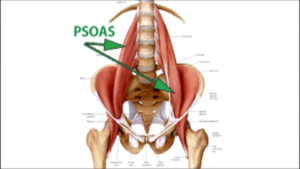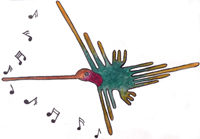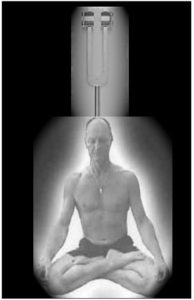6) DISCHARGING PTSD SYMPTOMS, WITH TENSION RELEASE
STORING TENSION IN THE BODY
 The psoas are some of the largest muscles in the body, attaching the knees to the spine as shown in the diagram. They are the muscles you would engage during high-stepping flight, or to lift your leg parallel to the ground,
The psoas are some of the largest muscles in the body, attaching the knees to the spine as shown in the diagram. They are the muscles you would engage during high-stepping flight, or to lift your leg parallel to the ground,
When we are threatened and unable to fight or flee from danger, these muscles instinctively protect our belly from attack by pulling us into a crouched fetal position.
After external restraint to fighting or fleeing the danger has passed, the body will naturally try to discharge residual tension in the psoas by having them quiver or shake.
Such muscles can stay contracted and tense for a life time if this natural trembling response is interrupted by continued restraint, alcohol, drugs, or shame. For the military, “shaking in your boots” is akin to cowardice.
All the enormous physical energy that would normally be discharged in fighting or fleeing, is then “frozen” as emotional tension in these large leg muscles.
Without release, tense sensations will eventually disappear and the muscles will become chronically tight, which is why some traumatized people become “up tight”, “high strung” or hyper-vigilant.
There is a causal link between addictions and unresolved traumatic experiences. The research literature is unequivocal: most hard-core substance abusers come from abusive homes.
It is well known that there is a high incidence of alcoholism and drug abuse among those suffering from PTSD.
In such cases of severe anxiety disorder, their intrusive thoughts, nightmares and insomnia are obviously related to traumatic memories.
But what about the millions addicted to tobacco, prescribed drugs, food, love, sex, hoarding, texting, gaming, or simple TV watching?
Does the link between trauma and addictions apply to workaholics, gamblers, criminals and other adrenalin junkies?
Do all addicts have unresolved traumatic experiences locked as emotional tension in their bodies?
A simple explanation of the link comes from the stories of millions of addicts attending twelve-step programs around the world.
Addicts in recovery often state that they had been uncomfortable in their own bodies, and that their addictive substance or behaviour made them feel different, at least temporarily more relaxed, peaceful, comfortable, sociable, accepted,loved,energized, powerful, passionate, and alert.
But, then what caused their discomfort in the first place?
At the level of the brain, it could be a problem with neurotransmitters like dopamine.
At the mental level, it might be intrusive thoughts, unconscious or repressed traumatic memories.
At the level of the body, I believe this “dis-ease” is emotional tension stored in our musculature.
WHY IS THIS MAN SMILING?
 This photo of me was taken in 2013, immediately after shooting our footage for Video 6 – “Emotional Tension Release”.
This photo of me was taken in 2013, immediately after shooting our footage for Video 6 – “Emotional Tension Release”.
Can you see any trace of craving, anxiety, fear, anger, or distress in my 68 year old face?
It is now hard for me to believe that for most of my life I suffered from secondary PTSD, anxiety, mood disorder and addictions.
My current serenity is due at least in part to my releasing trauma that was locked into my seven year old body after my father’s death.
MY ELEVENTH STEP
 I had been practising meditation & yoga regularly for forty years, yet I was still a heavy drinker. On Dec 9th, 2011 I got a clear message from deep within myself, “I want to be sober when I die”.
I had been practising meditation & yoga regularly for forty years, yet I was still a heavy drinker. On Dec 9th, 2011 I got a clear message from deep within myself, “I want to be sober when I die”.
When I related this to an old drinking buddy, who by then had 20 years of sobriety, he quipped,
“Makes sense, otherwise you wouldn’t remember what dying was like.”
A month later, I attended my first Alcoholics Anonymous meeting in the UNESCO Mexican hill town, San Miguel de Allende.
I discovered that I was addicted to many more things than alcohol, and subsequently joined several other 12 step programs.
I realized that the same alcoholic, obsessive thinking applied to other aspects of my life, such as my compulsion to avoid social intimacy.
I related immediately to the solitary, meditative aspects of AA’s suggested eleventh step towards recovery.
In my own attempt to increase conscious contact with my “higher power” or deeper wisdom, I began practising Emotional Tension Release at the beginning of my daily yoga routine. The memories that were released were of being swarmed, bullied, and abused by gangs shortly after my father died.
Emotional tuning helped me dissolve these forgotten memories of group abuse and reduce their emotional charge of fear and anger. Afterwards, I began to truly enjoy the company of other people and joined into community with other healing facilitators.
VIDEO 6-EMOTIONAL TENSION RELEASE
Video 6 -“Emotional Tension Release” builds on “Emotional Tuning” protocols demonstrated in Videos 1 to 5.1. After releasing physical tensions, we can use these protocols to help dissolve any traumatic memories that might have been shaken loose in the process.
In order to follow the video instructions, we position our monitor where we can view it while lying on our back. To proceed, click the forward button> below
Once you have become proficient in practicing the protocols demonstrated in Video 6,
please proceed to 7) RECOVERING FROM PTSD
